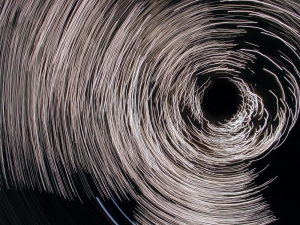Last night at dance class, we were exploring spins, rotational movements in which the pivot point is contained within the dancer’s body (as opposed to turns, in which the pivot point is outside the dancer). After reviewing the fundamentals of spinning, our instructor asked us to stand on one foot, not spinning, not moving, just standing. For most of us— but not all— that was relatively easy. Then she increased the challenge. While still standing on that one foot, she had us close our eyes. Immediately, a number of people toppled. (I know this even though my eyes were shut because I could hear the thumps as feet hit the floor.)
In the physical body, balance is maintained by three main things:
1. The inner ear. It is made of three fluid-filled semi-circular canals that sit at different angles. As your body rotates, the fluid in the canals moves. This movement triggers sensors in the canals that detect and interpret the direction of your head. If you’ve ever had an infection in the inner ear, you know the horrible vertigo that messed up inner ear signals can cause.
2. Proprioception. This is a ten dollar word for the awareness of where your body is in space using messages from receptors in your skin, muscles, and joints. Imagine you’re in a dark theater and you get a tickly sensation that feels like a spider is crawling up your left calf. Fast as a fly swatter, you can reach down in and slap the spot. Although you do it without thinking, it’s proprioception that lets you know how to make your hand hit that tickly spot is even when you can’t see your hand, your leg, or the imaginary spider.
3. The eyes. Your eyes send sensory information to your brain about your position and orientation in space. To get a sense of how important vision is to balance, try the exercise I described at the beginning.
So why am I talking about the fundamentals of spinning and encouraging you to stand on one foot with your eyes closed? Because taking away external visual cues while standing on one foot brings the internal cues required for balance into sharper focus and forces you to rely on those cues alone. In dance, closing your eyes is the best way to tune into your true center and evaluate your internal alignment, and the lessons we learn in the creative arts are often the lessons of life contained in a more manageable package. It’s easy to feel like you’re maintaining your balance when you’re relying someone or something else for support: a dance partner, a barre, a life partner, a status-filled job, or the promise of a matching 401K. It’s helpful to focus on an external focal point or target while executing a spin or aiming for a goal. It’s also common to be distracted by the movements of other dancers or your peers when you’re looking outwards. All of these external stimuli provide useful information and assistance, but they don’t provide everything. Only you can know what you need to do be in alignment with yourself and your purpose. Only by momentarily ignoring all the external attention grabbers and support structures, shutting your eyes, and focusing within (particularly while standing on one foot!) can you get in touch with your very own personal sense of balance. Once you do that, you can trust that next step forward, knowing that you are in complete alignment with your center. (For more information about what I do, please visit http://www.lisenaugle.com)
(For more information about what I do, please visit http://www.lisenaugle.com)
Love, love, love this, Lise! Similar concept to finding a drishdi, or nonmoving focal point, in yoga.
LikeLike
So glad you like it, Dena, and don’t worry, I’ll be doing some posts about yoga too!
LikeLike
Great thought to start the day, every day, thank you
LikeLike
Thank you, Kim.
LikeLike
Love this. Wanted to keep reading! Can’t wait for your next blog entry!!
LikeLiked by 1 person
Thanks for the reminder, Lise…words like proprioception take me back to my nurses’ training physiology (before I changed majors to become a medical social worker.)
LikeLiked by 1 person